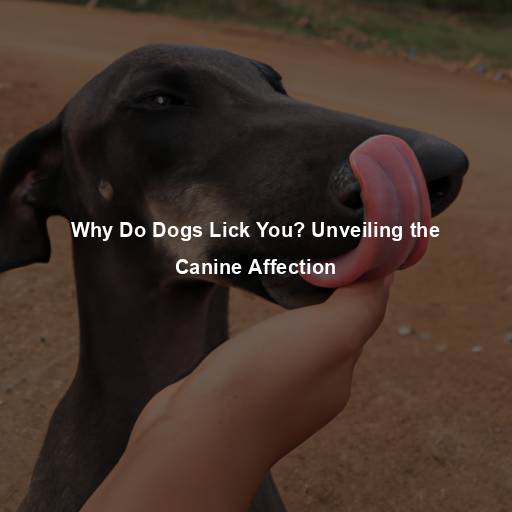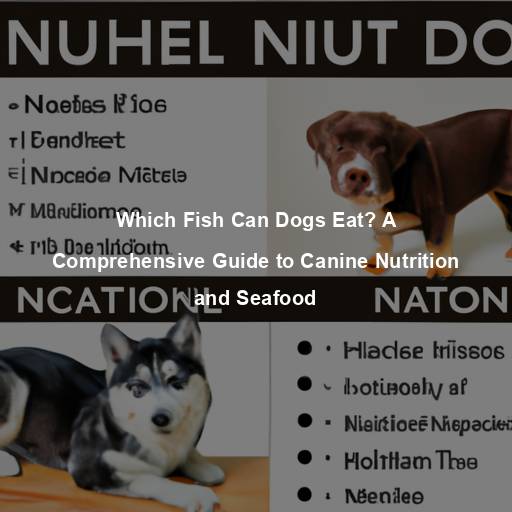Why Do Dogs Lick You? Unveiling the Canine Affection
Last Updated on October 30, 2023 by Evan
Contents [hide]
- 1 The Fascinating World of Canine Behavior
- 2 Embrace the Licks, Cherish the Love
- 3 Understanding and Responding to Dog Licking
- 4 FAQs: Why do dogs lick you?
- 4.1 What does it mean when dogs lick you?
- 4.2 Why do dogs lick people’s faces?
- 4.3 Is it safe to let dogs lick you?
- 4.4 How can I discourage my dog from excessive licking?
- 4.5 Are there any medical reasons why dogs lick excessively?
- 4.6 Can dogs lick as a sign of submission?
- 4.7 Should I allow my dog to lick wounds or injuries?
The Fascinating World of Canine Behavior
Dogs are undoubtedly one of the most beloved and cherished pets worldwide. Their loyalty, companionship, and unwavering love make them an integral part of countless households. As pet owners, we often find ourselves pondering the mysteries of our furry friends’ behavior. One question that frequently arises is, “Why do dogs lick us”?
The Language of Licks
In the fascinating world of canine communication, dogs have mastered the art of expressing themselves using a mesmerizing array of body language cues, vocalizations, and the ever-mysterious act of licking. Yes, you read that right – licking! This seemingly simple act holds profound significance in the intricate tapestry of their social interaction, serving as a bridge between dogs and their human partners. Through this seemingly innocuous gesture, dogs unlock a treasure trove of emotions, intentions, and messages that stem from their ancient instincts and the influences of their upbringing.
Puppies and the Mother’s Love
From the earliest moments of their existence, dogs have an uncanny knack for learning the art of licking. It’s a natural inclination ingrained in their being. In the tender embrace of their mother’s love, puppies are groomed through the act of licking, instilling a primal sense of bonding and care. Through this intimate gesture, not only are their tender bodies cleansed, but their very essence is awakened, their bodily functions stimulated.
Affection and Bonding
Just as a mother dog licks her puppies, dogs often lick their human caregivers to express affection and reinforce their bond. When a dog licks you, it signifies a strong emotional attachment and a desire to connect with you on a deeper level. It is their way of saying, “You are an important part of my pack, and I love you”.
Grooming and Hygiene
Licking is an inherent grooming behavior in dogs. In the wild, canines would lick themselves and each other to maintain cleanliness and hygiene. When dogs lick their human companions, they may be attempting to groom them, replicating their natural instincts. It is their way of showing care and ensuring that their pack members are well-groomed.
Taste and Exploration
Have you ever wondered why dogs can’t resist giving you a big lick? Well, it turns out that this seemingly simple act is actually a complex way for our furry friends to navigate the world around them. When dogs lick, they are not only exploring new scents and textures, but they are also trying to decipher the very essence of who you are. It’s their peculiar way of gathering information about your unique taste, scent, and overall state of being.
Seeking Attention and Social Interaction
Dogs are social animals, and they thrive on human interaction and attention. Licking can be a way for them to seek your attention, especially if they feel neglected or are in need of affection. It is their gentle nudge to remind you that they are there, eagerly waiting for your love and engagement.
Stress Relief and Calming Behavior
Just like us, our furry friends have their own unique coping mechanisms. Ever wondered why your dog can’t seem to stop licking? Well, it turns out that this seemingly peculiar behavior serves a purpose beyond just moisturizing their snack-craving tongues. Licking, for dogs, is more than just an oddly endearing habit – it’s a natural stress-reliever that triggers the release of those feel-good endorphins, allowing them to find a sense of tranquility amidst life’s chaotic moments.
Medical Reasons and Behavioral Issues
Licking – an act of affection and connection – usually brings joy and warmth to our hearts. Yet, amidst this tender display, there exists a world of perplexity and bewilderment. When a furry companion takes licking to a whole new level, it might be a fleeting glimpse into a hidden realm of medical turmoil or behavioral intricacies. Deep within this enigma lies the distinction between the ordinary and the aberrant, unraveling the delicate threads that connect comfort, injuries, allergies, and anxiety.
Embrace the Licks, Cherish the Love
As dog owners, we are blessed to experience the unconditional love and affection our furry companions shower upon us. Understanding the reasons behind their licking behavior allows us to deepen our bond and respond to their needs effectively. Whether it is a gentle lick on the hand or an enthusiastic face wash, embrace these canine kisses as a testament to the extraordinary connection we share with our dogs. So next time your pup showers you with slobbery licks, remember, it is their way of saying, “You are cherished, and I am grateful to have you in my life”.
- Explore the fascinating world of canine behavior
- Decode the reasons behind dogs’ licking behavior
- Understand the language of licks and its communication aspects
- Discover the role of affection and bonding in dogs’ licking behavior
- Unveil the grooming and hygiene significance of licking
- Learn how dogs use licking for taste exploration and seeking attention
- Recognize the stress relief and calming effects of licking for dogs
- Differentiate between normal licking and potential medical or behavioral concerns
- Embrace and cherish the love expressed through canine licks
There is a myriad of perplexing reasons as to why our beloved furry companions feel compelled to shower us with their slobbery kisses. From a scientific perspective, their licking behavior serves multiple purposes that range from displaying affection and building a strong bond, to indulging their instinctual grooming mechanisms and exploring new flavors. The intricate tapestry of motivations behind these wet displays of affection is a testament to the deep connection and love our four-legged friends have for us, and by unraveling these mysteries, we can enhance our bond with these extraordinary creatures and nurture the exceptional relationship we share. So, the next time your canine companion engulfs you in a burst of licky love, remember to embrace the unique connection you both possess and reciprocate the affection in a way that only humans know how.
Sensory Exploration and Identification
Did you know that dogs possess an extraordinary sense of smell? It’s true! And their tongues, believe it or not, have a crucial role in decoding the world around them. When they give a good lick to objects or even humans, their taste buds swing into action, enabling them to unravel different scents and flavors.
Smell Identification
Have you ever wondered how dogs seem to have an almost supernatural sense of smell? Well, it turns out their taste buds have a secret weapon: the vomeronasal organ. This hidden gem, nestled in the roof of their mouths, gives dogs the incredible ability to decipher scents on a whole new level. By licking various objects or even fellow canines, our furry friends can tap into a world of pheromones and chemical signals that unlock a wealth of information about their surroundings.
Taste and Saliva
Did you know that dogs have a surprisingly sophisticated palate? With their abundance of taste buds, these furry companions can savor a whole spectrum of flavors that elude human taste buds. But it doesn’t stop there – their saliva also plays a pivotal role in their exploration of the world through licking. Packed with enzymes, this magical liquid helps break down food particles and unveils a treasure trove of information about the objects they encounter.
Social Hierarchy and Submission
In a pack dynamic, dogs use various behaviors to establish social hierarchy and maintain order. Licking is one such behavior that reinforces the social structure within a group of dogs. When a dog licks another, it can be a sign of submission, respect, or a way to show deference to a higher-ranking member. Similarly, when a dog licks its human companion, it may be a way of acknowledging their authority or demonstrating their role within the family unit.
Stress Relief and Calming Effects
Licking can have a soothing and calming effect on dogs, similar to how certain activities or behaviors can help humans relax. When dogs feel anxious, stressed, or overwhelmed, licking releases endorphins that promote a sense of well-being and relaxation. It can serve as a self-soothing mechanism, helping dogs cope with challenging situations and find comfort in the repetitive motion of licking.
Attention-Seeking Behavior
Dogs, those enigmatic creatures of boundless energy and unwavering loyalty, possess an inherent need for social connection and unwavering devotion. And in their quest for the elusive companionship they so crave, they embark on a peculiar ritual of licking, their tongues a conduit for summoning the attention and engagement of their human counterparts. Through this enigmatic act, dogs deftly communicate their desire to partake in the delightful dance of play, loving caresses, and the tender exchanges of affection. In essence, their relentless licking serves as a poignant plea, whispering softly in the language of paws, “I long to engage with you, to be seen and cherished.
Learned Behavior and Reinforcement
Dogs have a curious way of connecting the dots, particularly when it comes to their slobbery tongues. The art of licking, it seems, has a mysterious power to unlock a world of rewards for our canine companions. Picture this: a dog enthusiastically licks its owner, only to be met with a shower of attention, praise, and perhaps even a tasty treat. Little do we know, this innocent act of affection can quickly transform into a calculated strategy for dogs to manipulate their human counterparts into fulfilling their every desire.
Environmental Factors and Cultural Differences
It’s important to recognize that the reasons behind dog licking can also be influenced by environmental factors and cultural differences. For example, in some cultures, licking is considered a sign of respect and affection. In other cases, specific training or conditioning methods may shape a dog’s licking behavior. Additionally, the environment in which a dog is raised and the interactions it has with its human caregivers can contribute to the frequency and context of licking behaviors.
Understanding and Responding to Dog Licking
As dog owners, it is crucial to understand and interpret our furry friends’ licking behavior accurately. Here are some tips for responding to dog licking in a positive and appropriate manner:
Assess the Context
Consider the context in which the licking occurs. Is it a casual lick during a bonding moment, or is it excessive and accompanied by signs of discomfort or anxiety? Understanding the context can help you determine whether the licking is a normal behavior or if it requires further attention and investigation.
Observe Body Language
Pay attention to your dog’s body language when they lick you. Are they relaxed, wagging their tail, and maintaining eye contact? This can indicate a positive and friendly interaction. However, if your dog appears tense, avoids eye contact, or exhibits other signs of stress, it may be a signal that something is amiss.
Set Boundaries
When it comes to dogs and their affinity for licking, there is a fine balance between natural instincts and setting clear boundaries. If the incessant licking becomes a nuisance or starts to make you feel uneasy, handling it with poise is key. Gently divert your furry friend’s attention to something else or offer them a delightful chew toy as a healthy alternative. By staying consistent and using positive reinforcement, you can guide your dog towards more appropriate behaviors, finding the perfect harmony between affection and moderation.
Regular Grooming and Dental Care
As pet owners, we all know that our furry friends love to lick themselves to stay clean. However, excessive licking can sometimes become a concern. To tackle this issue, it’s essential to establish a regular grooming routine for your dog. This includes brushing their coat to keep it in tip-top shape, trimming their nails to prevent any accidental scratches, and cleaning their ears to avoid any nasty infections.
Seek Professional Guidance
If you are concerned about your dog’s licking behavior or suspect underlying medical, behavioral, or anxiety-related problems, it is always advisable to seek guidance from a veterinarian or a professional dog behaviorist. They can assess your dog’s specific situation, provide tailored advice, and address any underlying issues that may be contributing to the behavior.
No two dogs are alike, and that includes their licking habits! It’s important to recognize that each pup has their own reasons for dishing out those wet kisses. By deciphering the messages behind their licks and taking the appropriate action, we can cultivate a deep and rewarding bond with our furry friends. So go ahead, bask in the slobbery affection, treasure the love they share, and dive deeper into the intriguing realm of canine communication.
- Understand the science behind canine licking, including sensory exploration and identification
- Explore the role of social hierarchy and submission in licking behavior
- Discover the stress relief and calming effects of licking for dogs
- Recognize attention-seeking behavior and learned associations in licking
- Consider environmental factors and cultural differences that may influence licking behavior
- Learn how to respond to dog licking with appropriate boundaries and positive reinforcement
- Maintain regular grooming and dental care to address excessive licking
- Seek professional guidance if concerned about underlying medical or behavioral issues
After delving deep into the world of dog licking, one thing becomes abundantly clear – it’s a fascinating phenomenon that defies simple explanations. From sensory exploration to social dynamics and stress management, the myriad motivations behind this behavior keep us on our toes. By unraveling the science behind it all and responding in kind, we can truly enhance our connection with our four-legged pals and guarantee their happiness. So, let the slobbery affection persist, for it is in these wet kisses that we find the purest embodiment of love from our furry companions.
FAQs: Why do dogs lick you?
What does it mean when dogs lick you?
Have you ever wondered why our furry friends decide to unleash their tongues upon us? It’s a doggone intriguing mystery! The act of licking is like a canine language, a message they convey with confusing fluency. Sometimes it’s a pure display of affection, a wet kiss to show their unwavering love. Other times, it’s an attempt to assert their dominance, a lick to claim their rightful place in the pack. But wait, there’s more! Licking might be their way of seeking solace in our presence, a doggy SOS when they’re feeling overwhelmed. And let’s not forget, it can also simply be a case of self-care, a meticulous grooming session to keep their fur fabulously flawless. The complexities of the licking phenomenon are as endless as a dog’s enthusiasm for belly rubs!
Why do dogs lick people’s faces?
Have you ever wondered why dogs can’t resist giving you a big, sloppy lick on the face? Turns out, this slobbery display isn’t just a sign of affection, but also a way for them to establish a deeper connection with their human pals. From the very beginning, puppies learn this behavior from their mothers, who use gentle face-licking as a grooming technique and a loving gesture towards their offspring. And as if that wasn’t intriguing enough, it turns out that dogs also rely on the taste and scent they gather from licking our faces to identify and remember their beloved owners or familiar faces. Who knew that a simple lick could hold such a wealth of perplexing information?
Is it safe to let dogs lick you?
When it comes to the age-old debate of whether you should let dogs lick you or not, it’s essential to approach the topic with a fair amount of caution. While dogs are generally known to be good boys and girls who mean no harm, there are certain situations where we need to tread carefully. Individuals who fall into the categories of young children, older adults, or those with weakened immune systems should exercise extra vigilance. Although rare, there is a slim possibility of bacteria and parasites hitching a ride on a dog’s tongue, potentially causing infections or illnesses. To mitigate any potential risks, it’s always a good idea to maintain good hygiene practices, like washing your hands and face thoroughly after receiving a slobbery kiss from your furry companion.
How can I discourage my dog from excessive licking?
When it comes to your furry friend’s relentless licking habits, it’s natural to feel puzzled and a tad overwhelmed. Luckily, there are a few strategies that can help you navigate this perplexing situation. One approach is to divert your dog’s attention, enticing them with a new activity or plaything to distract them from their licking frenzy. Engaging their mind with interactive toys or training exercises can also provide some much-needed mental stimulation, minimizing their compulsion to lick. Don’t forget the power of boundaries and consistency – teaching them the “no lick” command and reinforcing it regularly can work wonders. If the issue persists or escalates, reaching out to a professional dog trainer or behavior expert can provide valuable insights and guidance.
Are there any medical reasons why dogs lick excessively?
Have you ever wondered why your furry companion becomes a full-time licker? It may seem cute at first, but excessive licking in dogs can be a perplexing behavior. Hidden beneath that innocent gesture might be an underlying medical issue, such as allergies, skin irritations, pain, anxiety, or even compulsive disorders. It’s essential to pay attention to your dog’s licking habits, especially if it’s focused on specific areas. If you find yourself in this puzzling situation, seeking the guidance of a veterinarian can shed some light on the matter. With their expertise, they can evaluate your dog’s overall health and provide appropriate medical treatment or behavior modification plans to alleviate their burst of excessive licking.
Can dogs lick as a sign of submission?
Yes, licking can be a submissive gesture for dogs. When dogs lick another dog or a person, they may be showing deference or submissiveness. This behavior can be seen during interactions with dominant individuals or in unfamiliar situations where the dog wants to establish a non-threatening stance. It is important to understand your dog’s body language and the context in which they lick to better interpret their intentions and emotions.
Should I allow my dog to lick wounds or injuries?
When it comes to our furry friends, there’s often a swirl of advice and opinions that can leave us feeling bewildered. One topic that sparks a lot of curiosity is whether it’s safe to let dogs lick wounds. While it’s true that a dog’s saliva contains some antibacterial properties, it’s important to tread carefully, as their saliva also carries a mix of bacteria that can potentially hinder the healing process. As such, it’s always wise to seek guidance from a trusted veterinarian who can provide expert advice on how to properly clean and dress any wounds, ensuring our pets receive the care they need for a speedy recovery.







